2080 Ti Vs 2080 Ti Sli
Intro
The RTX 3090 FE vs. RTX 2080 Ti x2 mGPU using SLI, Pro Apps & Workstation and GPGPU benchmarks
This review follows up on the RTX 3090 Founders Edition (Atomic number 26) launch review. Information technology is the fastest video card in the world, and information technology is a GeForce optimized for gaming – information technology is not a TITAN nor a Quadro replacement. However, we demonstrated that it is very fast for SPEC and GPGPU benches, and its huge 24GB vRAM framebuffer allows it to excel in many pop creative apps making it specially fast at rendering.
The RTX 3090 is NVIDIA's flagship card that commands a premium toll of $1500, and some gamers and pro app users may consider buying a second RTX 2080 Ti every bit an culling for SLI/mGPU (Multi-GPU) gaming, pro apps, SPEC, GPGPU, and for creative apps. So we purchased a EVGA RTX 2080 Ti XC from eBay and a RTX TITAN NVLink Loftier Bandwidth bridge from Amazon to test 2 x RTX 2080 Tis versus the RTX 3090.
The RTX 3090 is the fastest video card for gaming and it is the first card to be able to run some games at 8K. Just the RTX 2080 Ti is still very capable equally NVIDIA's former flagship card, and we will demonstrate how two of them perform in SLI/mGPU games, SPECworkstation3, artistic apps using the Blender 2.ninety and OTOY benchmarks, and in Sandra 2020 and AIDA64 GPGPU benchmarks. In addition, nosotros volition too focus on pro applications similar Blender rendering, DaVinci's Black Magic, and OTOY OctaneRender. It volition be interesting to see if two RTX 2080 Ti's pool their memory to 22GB using these pro apps versus the RTX 3090 24GB.
We benchmark SLI games using Windows x 64-bit Pro Edition at 2560×1440 and at 3840×2160 using Intel's Core i9-10900K at 5.i/5.0 GHz and 32GB of T-FORCE DARK Z 3600MHz DDR4. All benchmarks use their latest versions, and we use the aforementioned GeForce Game Set drivers for games and the latest Studio driver for testing pro apps.
Permit's check out our test configuration.
Exam Configuration
Test Configuration – Hardware
- Intel Core i9-10900K (HyperThreading/Turbo boost On; All cores overclocked to v.1GHz/v.0Ghz. Comet Lake DX11 CPU graphics)
- EVGA Z490 FTW motherboard (Intel Z490 chipset, v1.3 BIOS, PCIe 3.0/3.1/3.2 specification, CrossFire/SLI 8x+8x), supplied past EVGA
- T-Strength Nighttime Z 32GB DDR4 (2x16GB, dual channel at 3600MHz), supplied by Team Grouping
- RTX 3090 Founders Edition 24GB, stock clocks on loan from NVIDIA
- RTX 2080 Ti Founders Edition 11GB, clocks set up to match the EVGA card, on loan from NVIDIA
- EVGA RTX 2080 Ti Blackness 11GB, manufacturing plant clocks
- 1TB Team Group MP33 NVMe2 PCIe SSD for C: bulldoze
- 1.92TB San Disk enterprise class SATA Three SSD (storage)
- 2TB Micron 1100 SATA 3 SSD (storage)
- 1TB Squad Group GX2 SATA III SSD (storage)
- 500GB T-FORCE Vulcan SSD (storage), supplied by Squad Group
- ANTEC HCG1000 Extreme, 1000W gold ability supply unit
- BenQ EW3270U 32″ 4K HDR 60Hz FreeSync monitor
- Samsung G7 Odyssey (LC27G75TQSNXZA) 27″ 2560×1440/240Hz/1ms/1000-SYNC/HDR600 monitor
- DEEPCOOL Castle 360EX AIO 360mm liquid CPU cooler
- Phanteks Eclipse P400 ATX mid-tower (plus 1 Noctua 140mm fan) – All benchmarking performed with the example closed
Test Configuration – Software
- GeForce 456.38 – the concluding driver to offer a new SLI contour. Game Prepare (GRD) drivers are used for gaming and the Studio drivers are used for pro/creative, SPEC, workstation, and GPGPU apps.
- High Quality, adopt maximum performance, single display, stock-still refresh, prepare in the NVIDIA control panel.
- VSync is off in the command console and disabled for each game
- AA enabled every bit noted in games; all in-game settings are specified with 16xAF always applied
- Highest quality sound (stereo) used in all games
- All games have been patched to their latest versions
- Gaming results evidence average frame rates inbold including minimum frame rates shown on the chart next to the averages in a smalleritalics font where higher is meliorate. Games benched with OCAT show average framerates butthe minimums are expressed past frametimes (99th-percentile) in ms where lower numbers are improve.
- Windows ten 64-fleck Pro edition; latest updates v2004.
- Latest DirectX
- MSI'due south Afterburner, 4.6.iii beta
- OCAT 1.six
SLI/mGPU Games
- Strange Brigade
- Shadow of the Tomb Raider
- Ashes of the Singularity, Escalation
- P roject CARS 2
- Star Wars: Jedi Fallen Order
- The Outer Worlds
- Destiny ii Shadowkeep
- Far Cry New Dawn
- RTX Quake Ii
Synthetic
- TimeSpy (DX12)
- 3DMark FireStrike – Ultra & Extreme
- Superposition
- Heaven 4.0 benchmark
- AIDA64 GPGPU benchmarks
- Blender 2.90 benchmark
- Sandra 2020 GPGPU Benchmarks
- SPECworkstation3
- Octane benchmark
Professional Applications
- Black Magic Design DaVinci Resolve, supplied past NVIDIA
- Blender 2.90
- OTOY Octane Render 2020 i.five Demo – 8K Redcode RAW projects
NVIDIA Control Panel settings
Here are the NVIDIA Control Console settings.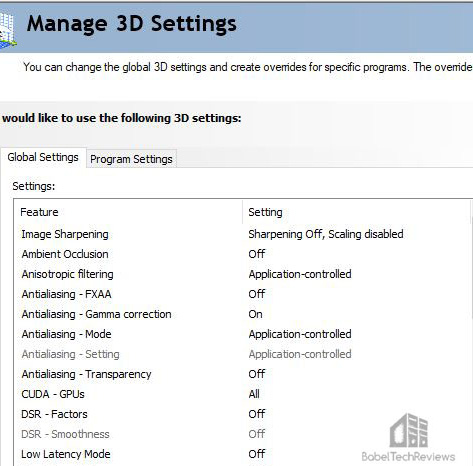


Nosotros used MSI's Afterburner to set all video cards' ability and temperature limits to maximum too equally to set the Founders Edition clocks to match the Ninety'southward clocks. Past setting the Power Limits and Temperature limits to maximum for each card, they exercise non throttle, but they can each attain and maintain their individual maximum clocks better. When SLI is used, it is set to NVIDIA optimized.
So allow's check out operation on the next page.
SLI & mGPU
BTR has always been interested in SLI, and the concluding review we posted was in January, 2018 – GTX 1070 Ti SLI with fifty games. Nosotros concluded:
"SLI scaling is proficient operation-wise in more often than not older games and where the devs specifically back up SLI in newer DX11 and in DX12 games. When GTX 1070 Ti SLI scales well, it easily surpasses a single GTX 1080 Ti or TITAN Xp in performance. . . . SLI scaling in the newest games – and especially with DX12 – is going to depend on the developers' support for each game [but] contempo drivers may interruption SLI scaling that in one case worked, and fifty-fifty a new game patch may touch SLI game performance adversely."
Fast forward 2-ane/2 years to today. There are all the same very few mGPU games, and NVIDIA has relegated SLI to legacy. They will not be adding whatever new SLI profiles, and the only Ampere card that supports it is the RTX 3090 using a new NVLink bridge – for benchmarking – to gear up world records in synthetic tests like 3DMark. NVIDIA has this to say about SLI back up "transitioning", quoted in function:
"NVIDIA volition no longer be adding new SLI driver profiles on RTX 20 Series and earlier GPUs starting on January 1st, 2021. Instead, we volition focus efforts on supporting developers to implement SLI natively within the games. We believe this will provide the all-time performance for SLI users.
Existing SLI driver profiles will proceed to be tested and maintained for SLI-set RTX 20 Serial and earlier GPUs. For GeForce RTX 3090 and future SLI-capable GPUs, SLI will only be supported when implemented natively within the game.
[Natively supported] DirectX 12 titles include Shadow of the Tomb Raider, Civilization VI, Sniper Elite iv, Gears of War iv, Ashes of the Singularity: Escalation, Strange Brigade, Rising of the Tomb Raider, Zombie Army 4: Dead State of war, Hitman, Deus Ex: Mankind Divided, Battlefield 1, and Halo Wars 2.
[Natively supported] Vulkan titles include Red Dead Redemption ii, Quake two RTX, Ashes of the Singularity: Escalation, Strange Brigade, and Zombie Ground forces 4: Dead War.
… Many creative and other non-gaming applications back up multi-GPU functioning scaling without the use of SLI driver profiles. These apps will continue to work across all currently supported GPUs as it does today."
It looks bleak for SLI'southward future and dev-supported mGPU titles are beyond rare. And so we tested our 40-game benching suite and identified simply nine games that scaled well with RTX 2080 Ti. Of the baker'southward dozen games that NVIDIA lists and that we accept, Civilization Six using the 'Gathering Storm' expansion benchmark did not scale, and Red Expressionless Redemption two crashed when nosotros tried to use it. The other games on their list are old and run dandy on any modern GPU negating any reason to use SLI anyway, except maybe for extreme supersampling.
We didn't carp listing the operation of games that barely calibration, scale negatively, or exhibit issues when SLI is enabled. That list is very long. Of class, there are still SLI enthusiasts who tweak their games with NVIDIA Inspector and roll dorsum to one-time drivers to indulge their hobby – but we utilise the latest drivers without tediously trying workarounds that may or may not exist successful.
Build-Gaming-Computers.com was able to identify a total of 57 games (out of many thousands) that scaled well or partially with SLI in 2020, and they have concluded that overall information technology isn't worth the trouble or the expense of maintaining two finicky cards using an extra-large PSU. However, here are nine relatively modern games that nosotros tested that show SLI scaling without a lot of microstutter or other issues associated with them.
SLI Gaming Summary Charts
Here are the summary charts of nine games and 3 synthetic tests that scale with mGPU or SLI. The highest settings are ever chosen and the settings are listed on the nautical chart. The benches were run at 2560×1440 and at 3840×2160. The first cavalcade represents the performance of a single RTX 2080 Ti, the second represents two RTX 1080 Tis, and the third cavalcade gives RTX 3090 results. 'X' means the game was not tested.
Near results show average framerates, and college is ameliorate. Minimum framerates are next to the averages in italics and in a slightly smaller font. Destiny 2, benched with OCAT evidence average framerates, only the minimums are expressed past frametimes (99th-percentile) in ms where lower is better.
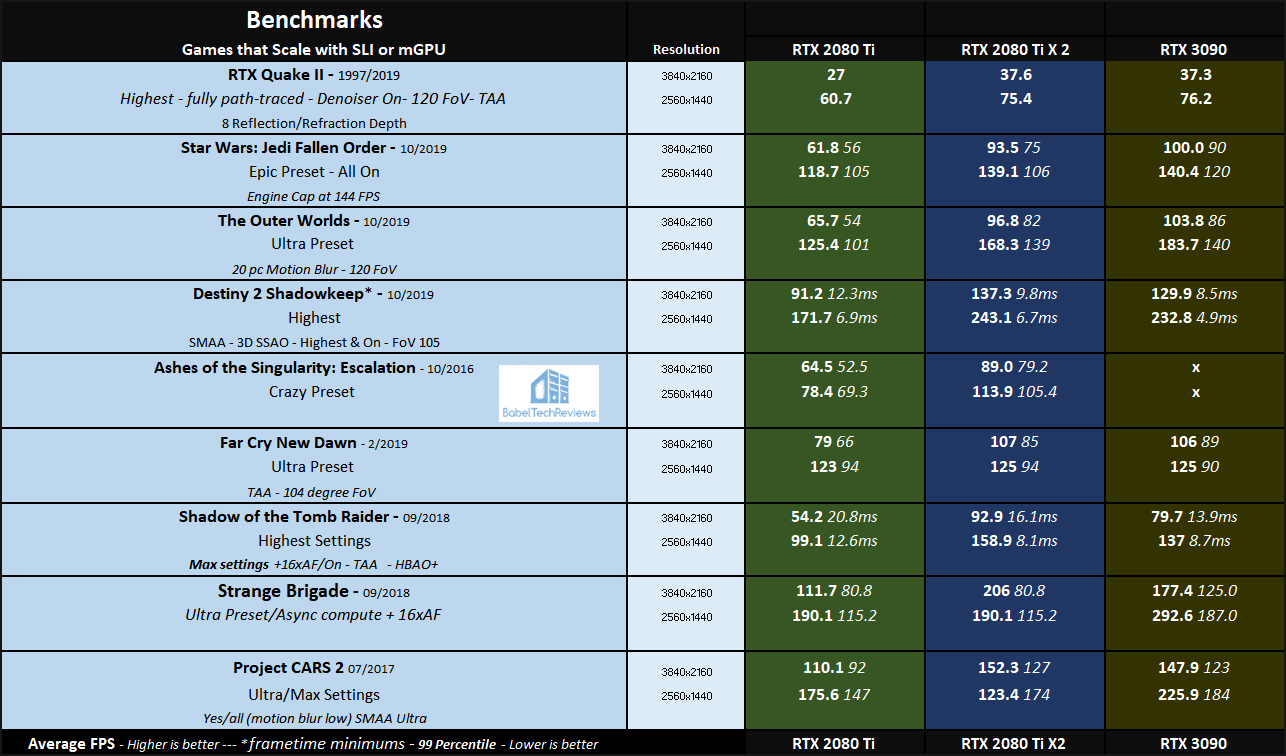
Although SLI scaling is good with these nine games at 4K, there are some issues with 256×1440 and framerate caps. We would prefer to play these 9 games with a RTX 3090 that has no problems with microstutter. Nevertheless, synthetic benches await pretty good.

Even though the RTX 2080 Ti has been surpassed past both the RTX 3080 and the RTX 3090, our PC scored in the top one% of all PCs using Fire Strike Ultra.
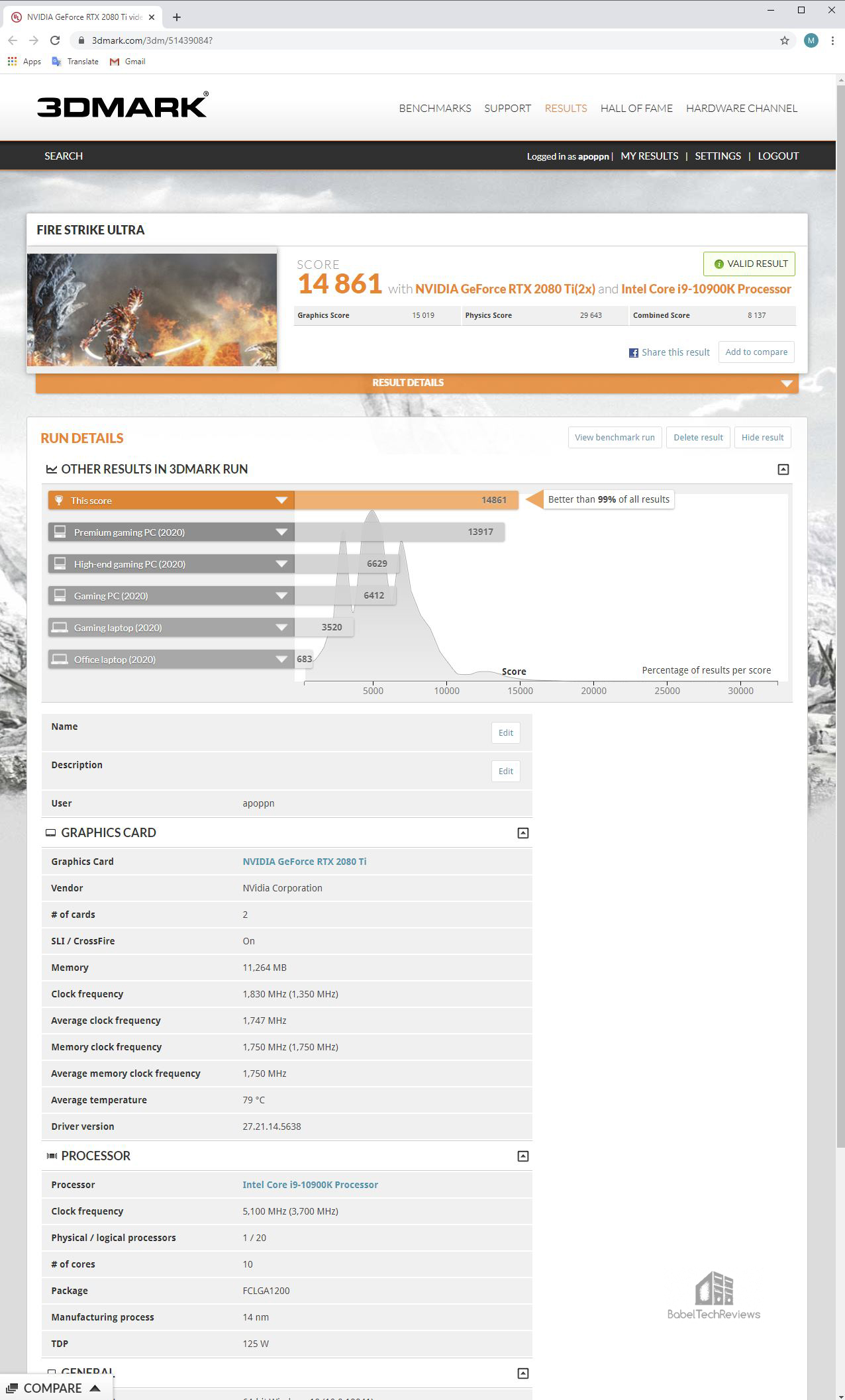
If you are a professional overclocker and/or desire to prepare a earth record, we would advise ownership 2 RTX 3090s for that purpose instead of using any two Turing video cards.
We cannot recommend SLI to any gamer unless they have a very large library of quondam(er) games that they revisit and play regularly and who don't listen the issues associated with tweaking and maintaining SLI profiles using one-time drivers. And so in that location is the added inconvenience of disabling SLI each time most modern games are played. Besides, at that place are the additional issues of heat and racket coupled with using two powerful cards with a large PSU, non to mention the expense of buying a second card, and the higher cooling ability bills associated with using SLI during the warm months of Summertime.
So permit's look at Creative applications next to come across if ii x RTX 2080 Tis are a viable choice versus the RTX 3090 starting with the Blender benchmark.
Blender 2.90 Benchmark
Blender is a very popular open up source 3D content creation suite. It supports every aspect of 3D evolution with a complete range of tools for professional 3D cosmos. We volition look at Blender rendering later in this review, but here are the official criterion results.
For the following results, lower is better as the criterion renders a scene multiple times and gives the results in minutes and seconds. First up, two RTX 2080 Ti's using the RTX TITAN NVLink span with CUDA.
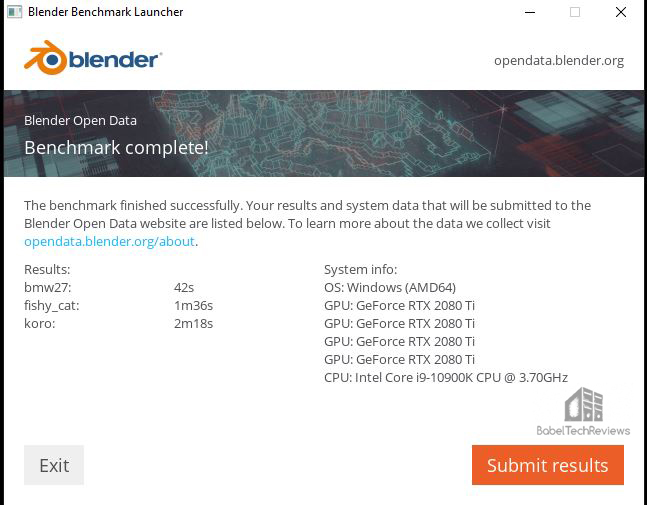
Side by side nosotros endeavour Optix using the two Tis.
There is no departure with SLI enabled or disabled. Here is the chart comparing the performance of a single RTX 2080 Ti with two versus a RTX 3090.
 Performance is worse using the second RTX 2080 Ti equally the benchmark is not optimized for a second video card. Yet, nosotros volition effort to return a big scene in Blender every bit nosotros show later.
Performance is worse using the second RTX 2080 Ti equally the benchmark is not optimized for a second video card. Yet, nosotros volition effort to return a big scene in Blender every bit nosotros show later.
Next nosotros look at the OctaneBench.
OTOY Octane Bench
OctaneBench allows you to benchmark your GPU using OctaneRender. The hardware and software requirements to run OctaneBench are the same as for OctaneRender Standalone and nosotros shall also employ OctaneRender for a specific rendering test later, under "Professional Apps".
Beginning nosotros run OctaneBench 2020.1 for windows, and hither are two NVlinked RTX 2080 Ti's complete results and overall score of 687.14.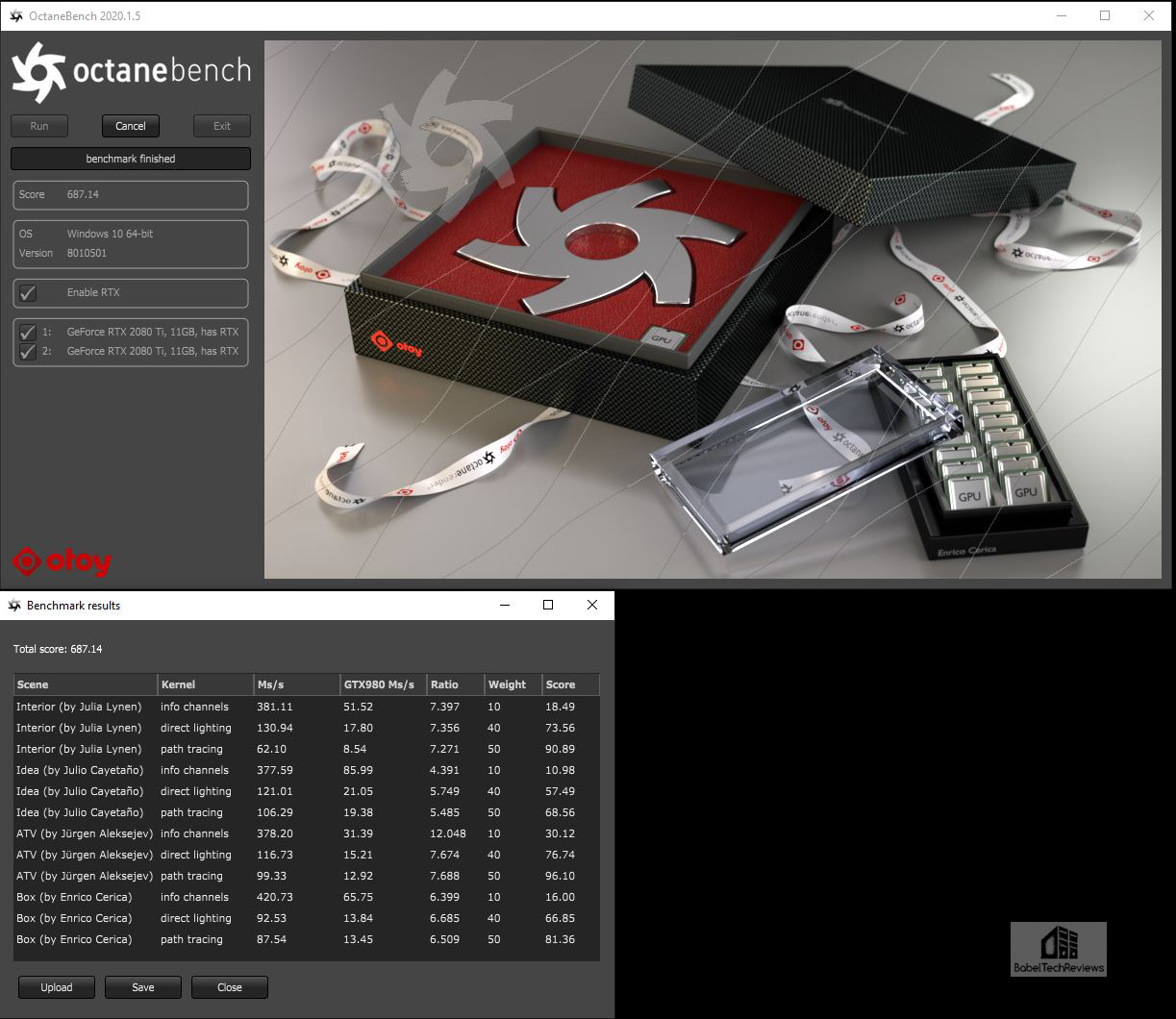
We run OctaneBench 2020.1 again and here are the RTX 3090'southward complete results and overall score of 652.thirty. 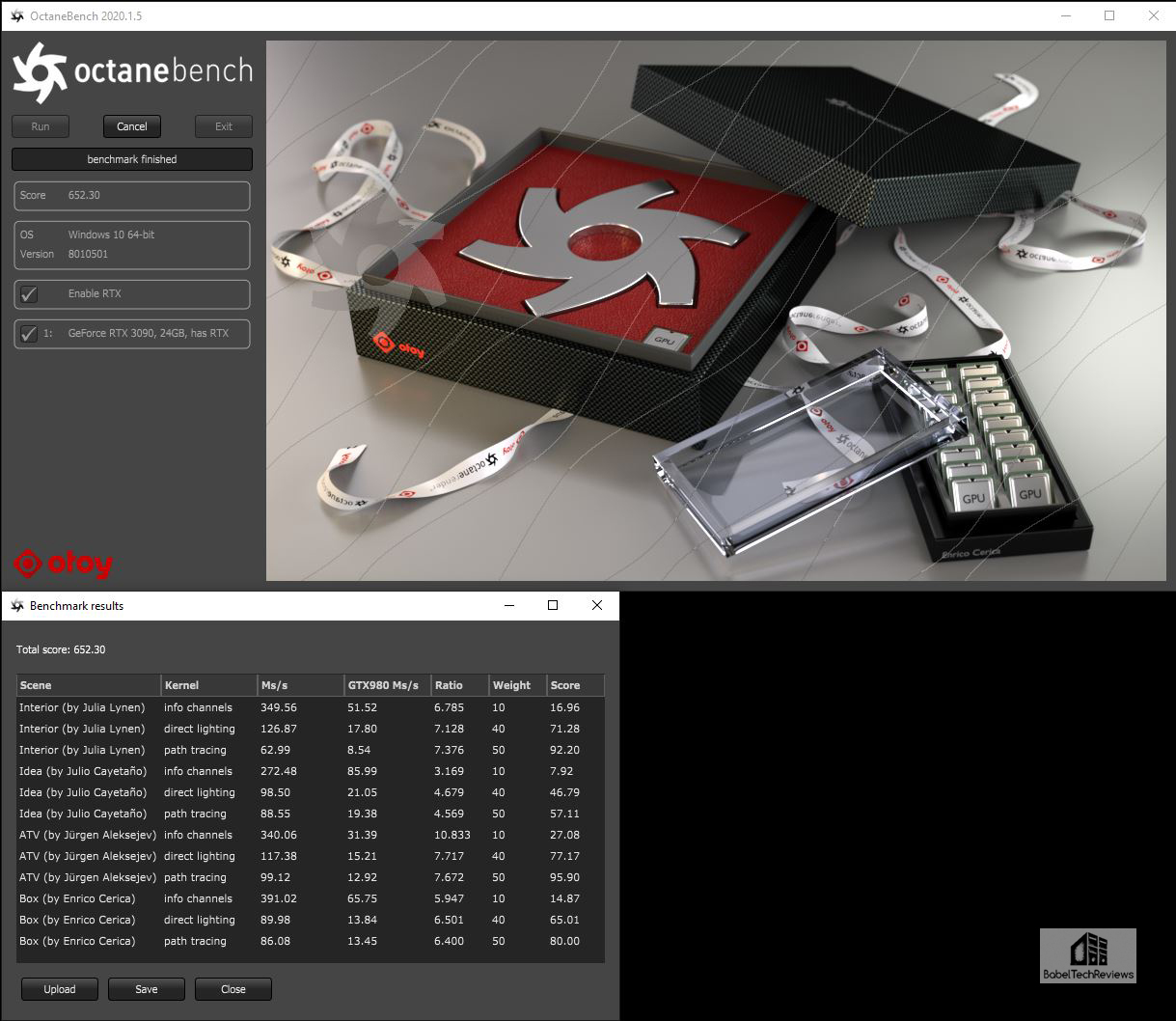
Nosotros have a win for 2 linked RTX 2080 Ti'due south scaling. Here is the summary chart.

Adjacent, we motion on to AIDA64 GPGPU constructed benchmarks that are congenital to scale with mGPU.
AIDA64 v6.25
AIDA64 is an of import industry tool for benchmarkers. Its GPGPU benchmarks mensurate performance and requite scores to compare against other popular video cards.
AIDA64's benchmark code methods are written in Assembly language, and they are generally optimized for popular AMD, Intel, NVIDIA and VIA processors by utilizing their appropriate education set extensions. Nosotros utilise the Engineer's full version of AIDA64 courtesy of FinalWire. AIDA64 is free to to try and employ for 30 days. CPU results are also shown for comparing with the video cards' GPGPU benchmarks.
First the results with a pair of RTX 2080 Tis.
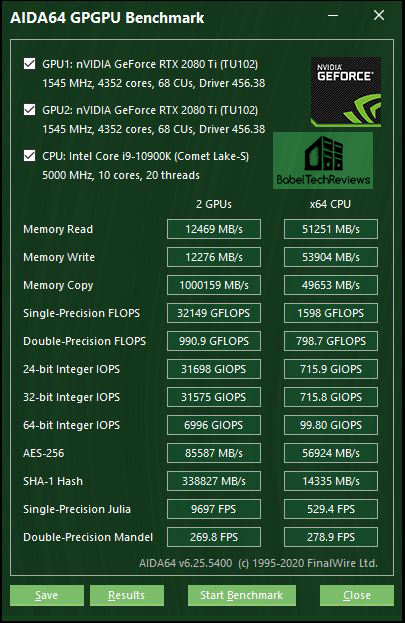
At present the RTX 3090:
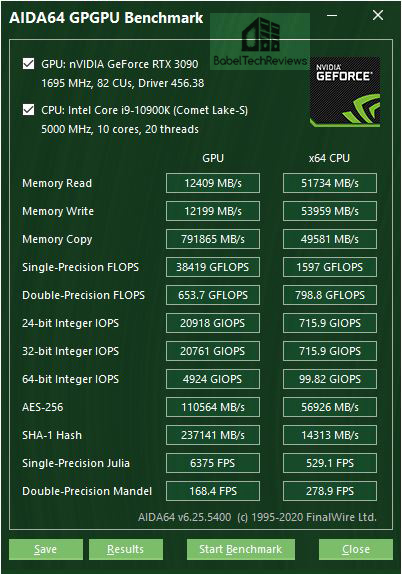
Here is the chart summary of the AIDA64 GPGPU benchmarks with the RTX 2080 Ti, the RTX 3090, and NVLinked RTX 2080 Tis side-by-side.
Again the pair of linked RTX 2080 Tis are faster at near all of AIDA64's GPGPU benchmarks including the RTX 3090. And then let'due south look at Sandra 2020 which which is also optimized for mGPU.
SiSoft Sandra 2020
To see where the CPU, GPU, and motherboard operation results differ, at that place is no better comprehensive tool than SiSoft's Sandra 2020. SiSoftwareSANDRA (theSystemANalyser,Diagnostic andReportingAssistant) is a fantabulous information & diagnostic utility in a complete package. Information technology is able to provide all the information nigh your hardware, software, and other devices for diagnosis and for benchmarking.
There are several versions of Sandra including a gratuitous version of Sandra Lite that anyone tin download and employ. Sandra 2020 R10 is the latest version, and nosotros are using the full engineer suite courtesy of SiSoft. Sandra 2020 features continuous multiple monthly incremental improvements over earlier versions of Sandra. It will benchmark and clarify all of the important PC subsystems and even rank your PC while giving recommendations for improvement.
We ran Sandra's extensive GPGPU benchmarks and charted the results summarizing them below. The performance results of the RTX 2080 Ti are compared with the performance results of the RTX 3090, and versus the two linked RTX 2080 Tis.
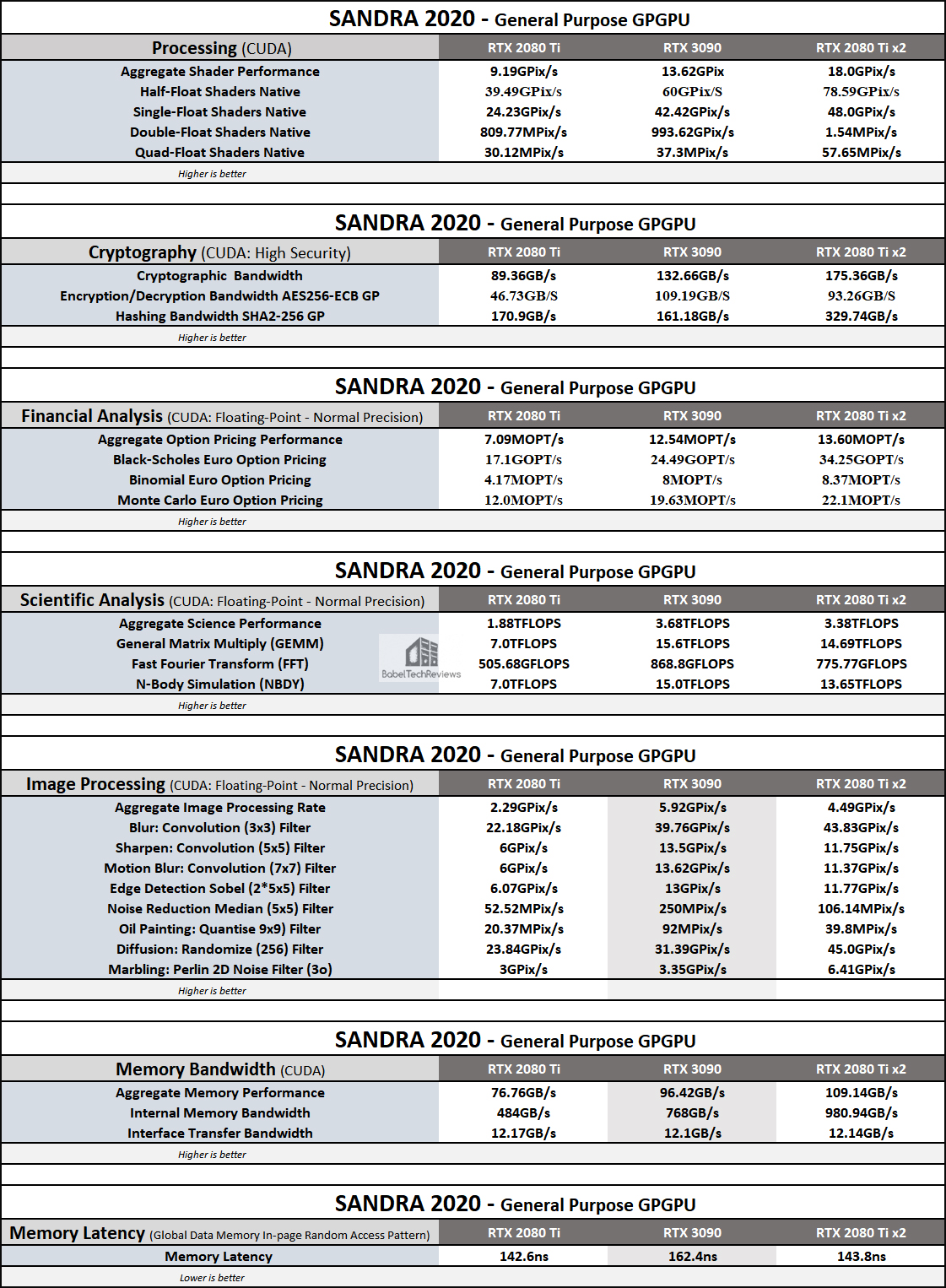
In Sandra synthetic GPGPU benchmarks which are optimized for mGPU, the linked RTX 2080 Tis are faster than the RTX 3090 and they by and large scale well over a single Ti. Next we motility on to SPECworkstation 3 GPU benchmarks.
SPECworkstation3 (3.0.4) Benchmarks
All the SPECworkstation 3 benchmarks are based on professional applications, most of which are in the CAD/CAM or media and entertainment fields. All of these benchmarks are gratuitous except to vendors of calculator-related products and/or services.
The about comprehensive workstation criterion is SPECworkstation 3. Information technology'south a free-standing benchmark which does non require ancillary software. Information technology measures GPU, CPU, storage and all other major aspects of workstation operation based on actual applications and representative workloads. We only tested the GPU-related workstation performance. We did not use SPECviewperf xiii since SPECviewperf 2020 is coming out in mid-October.
Hither are the SPECworkstation3 results for two linked RTX 2080 Tis. Higher is better since we are comparing scores.
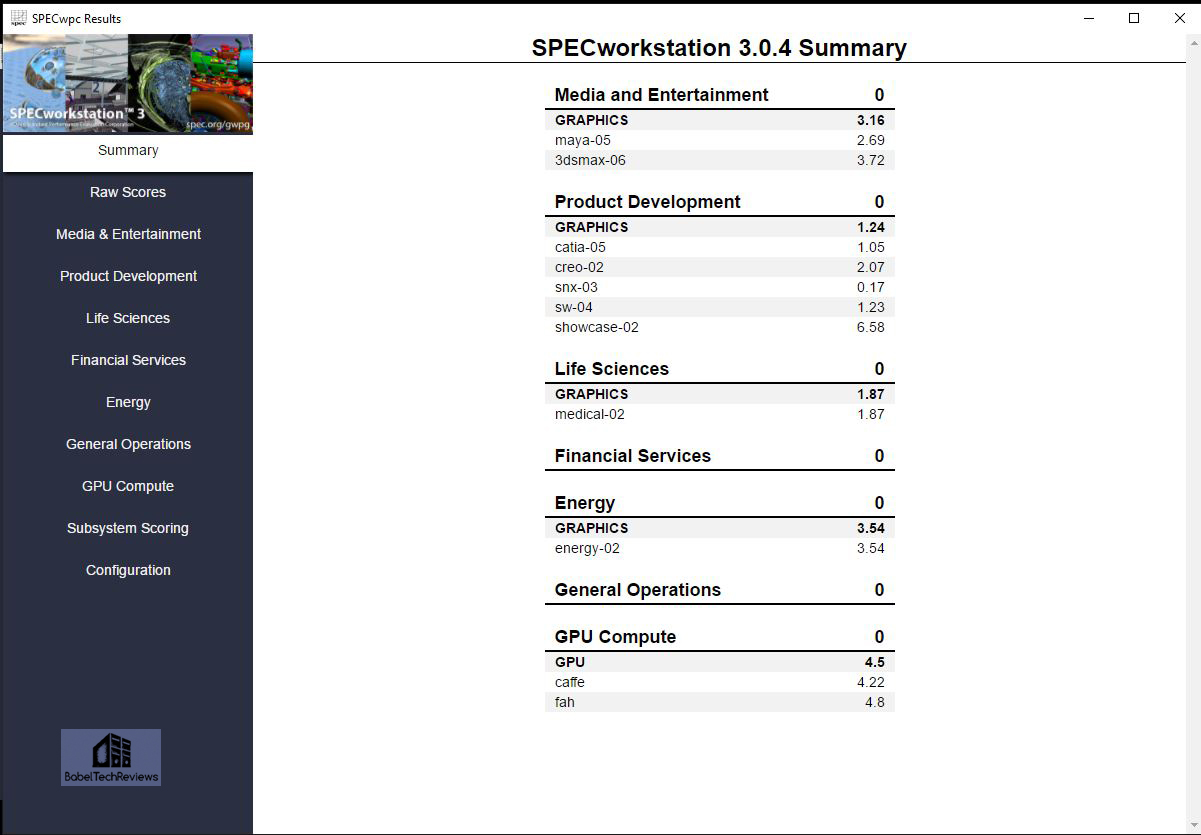
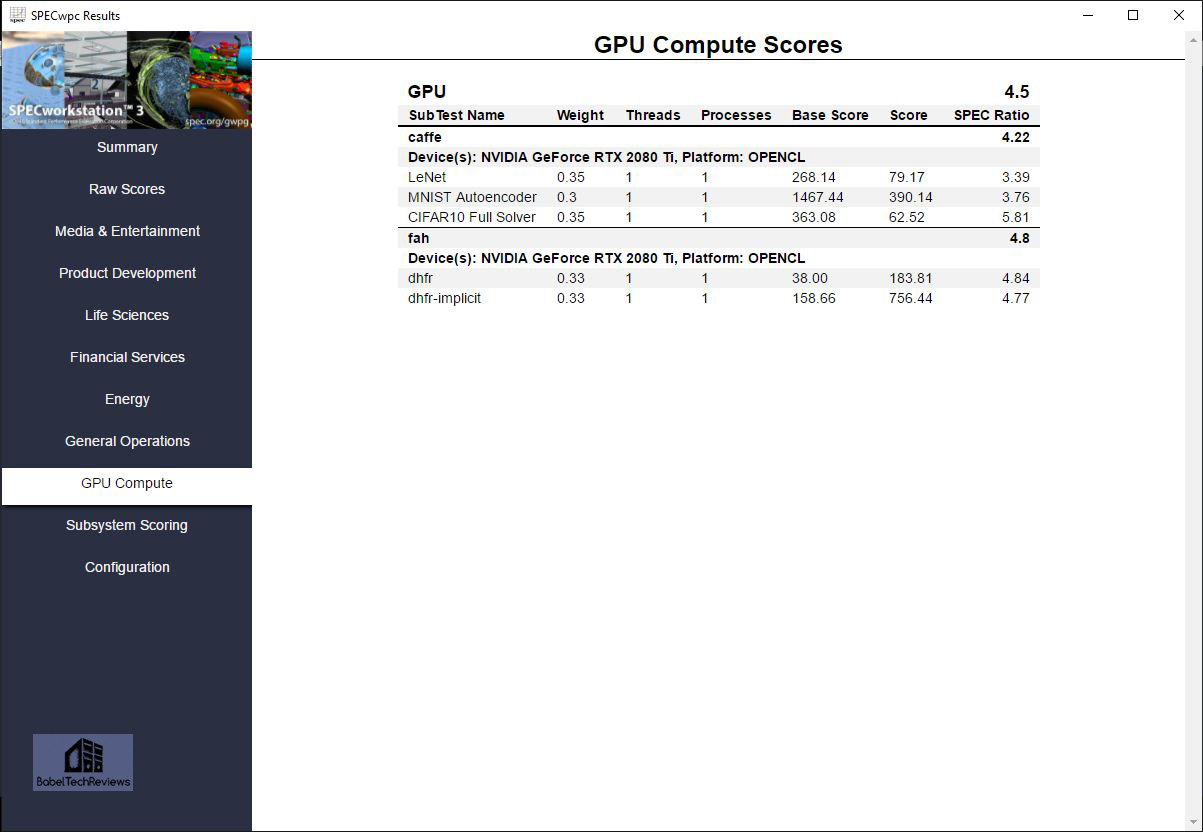 Hither are the SPECworkstation3 GPU benches summarized.
Hither are the SPECworkstation3 GPU benches summarized.

The RTX 3090 was unable to complete two benches, probably because of a conflict with Ampere's new drivers. But in that location is no scaling whatsoever, or negative scaling for the NVLinked RTX 2080 Tis. So we questioned the people who are responsible for maintaining the SPECworkstation benchmarks:
Q: I am comparing its SPECworkstation results with ii X RTX 2080 Ti that are connected using a RTX Titan NVLink HB Span. Are using two GPUs in this manner supported past the benchmark?
A: The brusk answer is "no", it will not produce the desired scaling effect if you bridge the two cards. The longer answer has more to do with your expectations and that the benchmark does not explicitly do anything to preclude multi-GPU scenarios from improving support, but it does not have whatsoever code that explicitly enables information technology.
The graphics portions of SPECworkstation come from SPECviewperf which, in turn, is based on recordings of real-world applications. The creation of a rendering context to draw 3D scenes is done in a style that tries to very closely mimic the real-world awarding and thus, if the real-world application would benefit from multiple GPUs, so might the viewsets that comprise the criterion.
The GPU compute portions of SPECworkstation run on but a single GPU. We are working toward multi-GPU support in the next major version only information technology'due south non in there now.
So mGPU scaling may depends on if a benchmark is optimized for it or not. However, permit's next look at some professional applications where a large memory buffer makes a big performance improvement over having a smaller one.
Creative Applications with Large Retentivity Workloads
Rendering large models, detailed scenes, and high-resolution textures require powerful GPUs with a lot of vRAM. Render artists using the highest quality renders, require high chapters GPU memory which allows them to create more than detailed terminal frame renders without needing to reduce the quality of their final output, or to split scenes into multiple renders which take a lot of extra fourth dimension. Until now, no GeForce has been equipped with 24GB of vRAM while the RTX 2080 Ti offers 11GB. Let'southward expect at three pro apps that can use much more than 11GB and besides test render times. First upwardly is OTOY OctaneRender.
OctaneRender
OctaneRender is the world's first spectrally correct GPU return engine with built-in RTX ray tracing GPU hardware acceleration. The RTX 3090 allows large scenes to fit completely into the 24 GBs of GPU memory and so out-of-cadre rendering is not necessary, providing faster than rendering times using out-of-core data for GPUs with lesser memory chapters. Nosotros tested the RTX 3090/24GB against the bridged RTX 2080 Tis.
Post-obit NVIDIA's very specific instructions, nosotros rendered a very large detailed paradigm. Looking closely, we see that out-of-cadre data was not needed since the unabridged render fit into the 24GB vRAM buffer, and the large image provided simply took 45 seconds to return. 
Nosotros tested the NVLinked RTX 2080 Tis, and it took much longer at ii minutes and 27 seconds because information technology requires much slower out-of-core memory. The 11GB vRAM of the RTX 2080 Tis are evidently not pooled for this return.

All the same, a pair of RTX 2080 Tis are faster than a single carte and the results are summarized in the chart below.

So for rendering, it appears that two linked RTX 2080 Tis are faster than one in OTOY rendering. Allow'due south wait at Blender next.
Blender
Blender is a popular free open up source 3D creation suite that supports modeling, rigging, animation, simulation, rendering, compositing, motion tracking, video editing, and the 2nd animation pipeline. NVIDIA's OptiX accelerated rendering in Blender Cycles are used to accelerate final frame rendering and interactive ray-traced rendering in the viewport to give creators existent-time feedback without the need to perform fourth dimension-consuming test renders. The 24 GB framebuffer on the RTX 3090 allows information technology to perform final frame together with interactive renders that may fail due to a smaller vRAM framebuffer on the RTX 3080 or issues with linked RTX 2080 Tis.
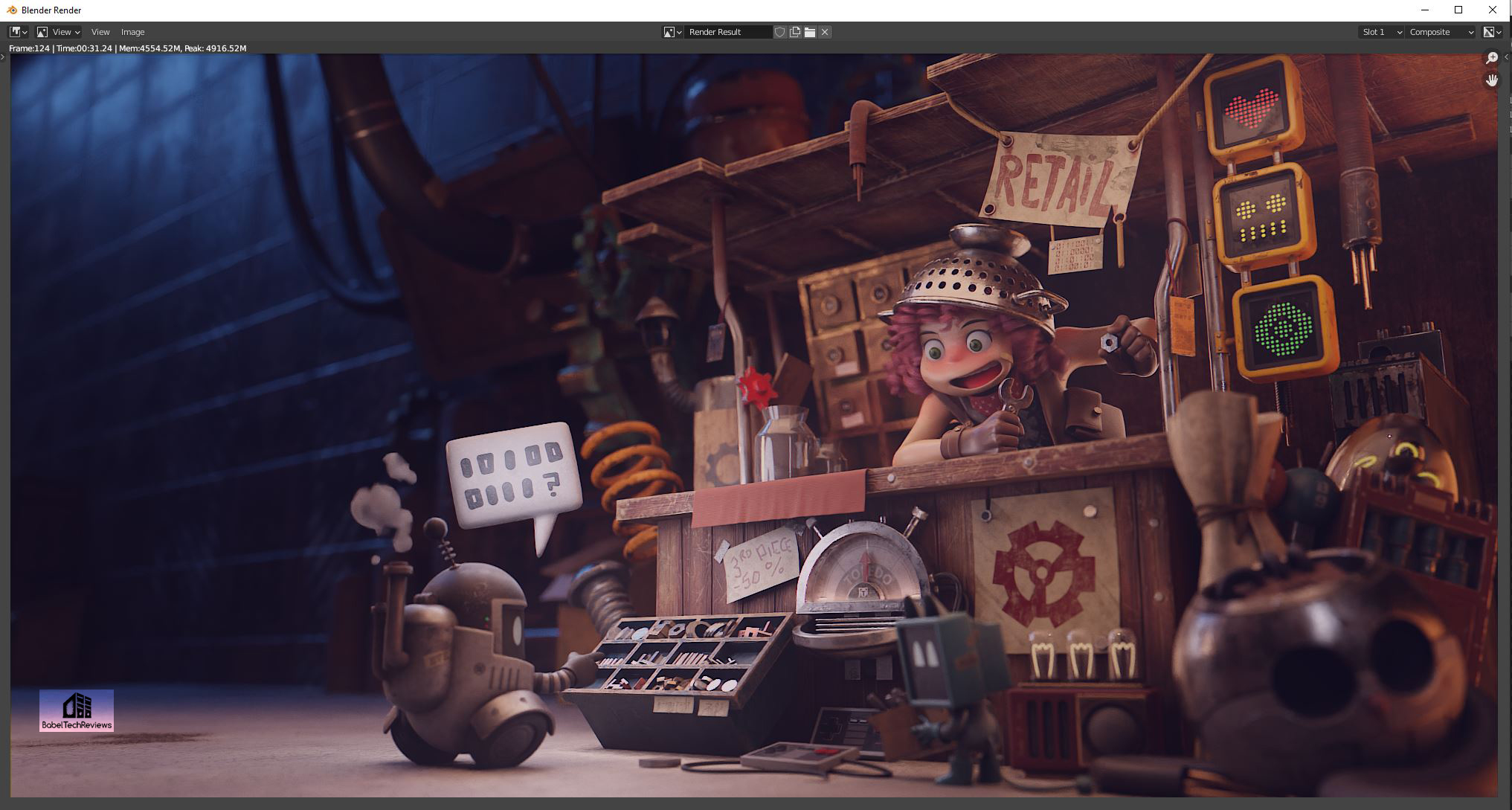
This large return took 31.24 seconds using the RTX 3090 simply information technology caused an error when we tried fitting the scene into the linked RTX 2080 Ti'southward framebuffer and it could non complete the render as shown below.
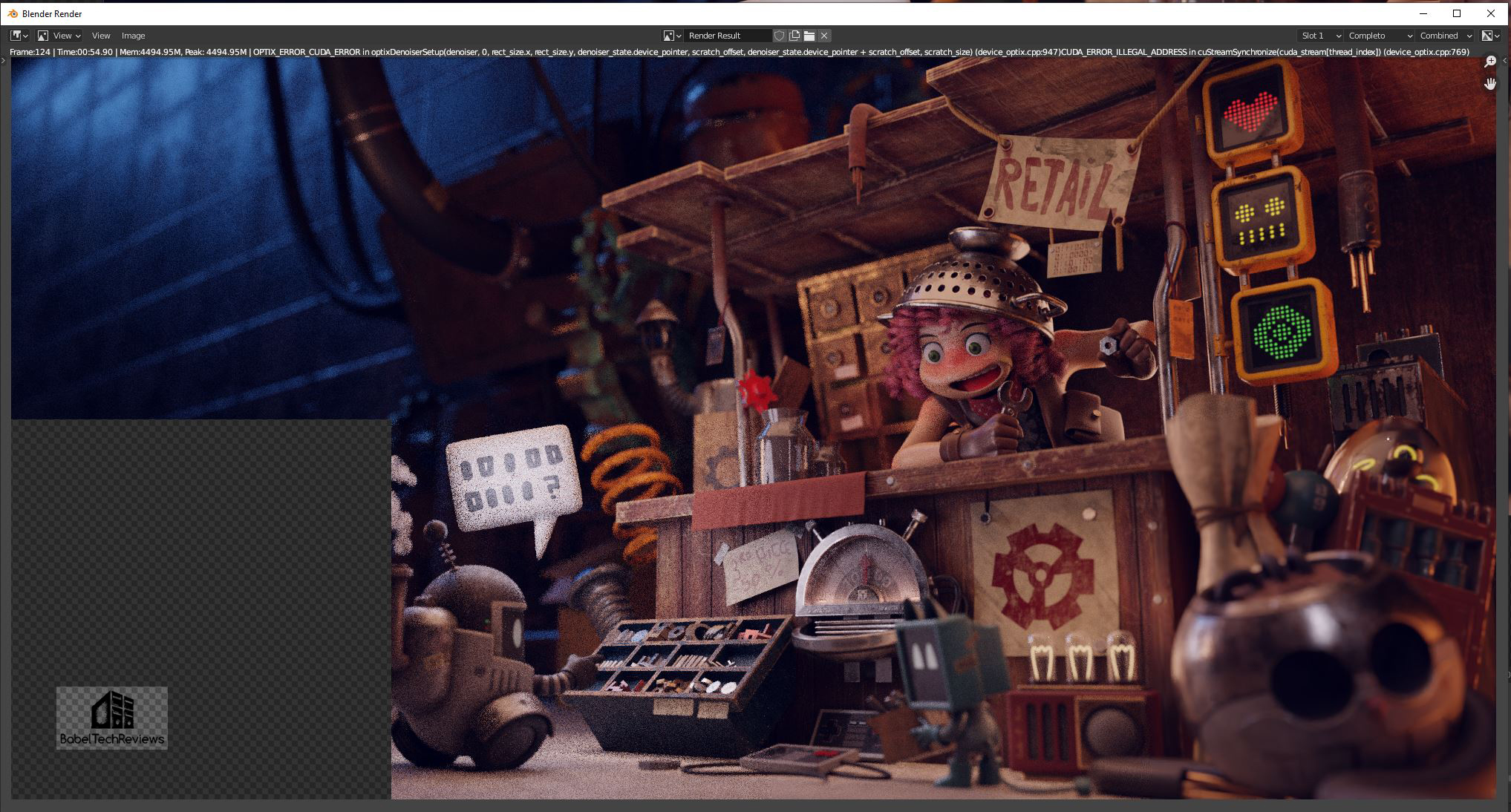
However, it did return with a single RTX 2080 Ti, and hither is the summary chart.

So in regard to mGPU and Blender rendering, it appears that "it depends".
Finally, we looked at Blackmagic Design DaVinci Resolve and 8K Redcode RAW projects.
Blackmagic Design DaVinci Resolve | 8K Redcode RAW projects
Blackmagic'southward DaVinci Resolve combines professional 8K editing, color correction, visual effects and audio post production into 1 software parcel. With 8K projects featuring 8K REDCODE Raw (R3D), files volition use most of the retention available on a RTX 3080 which result in out of memory errors particularly when intensive furnishings are added. Indeed, the RTX 3090/24GB was able to perform a very intensive LFB projection quickly using an 8K R3D Crimson CAMERA clip on an 8K timeline with a temporal dissonance reduction processing effect applied. In contrast, the RTX 3080 and a pair of RTX 2080 Tis simply generated mistake letters which means that nosotros would have to workaround – taking a lot of actress fourth dimension and endeavor. There is really no quantitative criterion hither.
Older unmarried cards – the RTX 2080 Ti and the TITAN Xp – can run many of these workloads with various degrees of success without errors, simply they are much slower than the RTX 3090.
Later seeing the totality of these benches, creative users will probably adopt to upgrade their existing systems with a new RTX 3090 based on the performance increases and the associated increases in productivity that they crave. The question to purchase the RTX 3090 or a second RTX 2080 Ti should probably exist based on the workflow and requirements of each user too as their budget. Time is coin depending on how these apps are used. If a professional needs a lot of framebuffer, the RTX 3090 is a logical choice. Hopefully the benchmarks that we ran may help y'all decide.
Let's head to our determination.
Conclusion
This has been an enjoyable exploration evaluating the Ampere RTX 3090 versus the a pair of NVLinked RTX 2080 Tis – formerly the fastest gaming menu in the globe. Overall, the RTX 3090 totally blows abroad its other competitors and information technology is much faster at most everything we threw at information technology. The RTX 3090 at $1499 is the upgrade from a (formerly) $1199 RTX 2080 Ti since a $699 RTX 3080 gives almost 20-25% improvement in 4K gaming. If a gaming enthusiast wants the very fastest card – just every bit the RTX 2080 Ti was for the past two years, and doesn't mind the $300 price increase – so the RTX 3090 is the but option.
Forget RTX 2080 Ti SLI as it is legacy, finicky, and requires workarounds with virtually games to get information technology to scale at all. SLI gaming uses too much ability, puts out extra heat and noise, and it works mostly with older games – merely if you are willing to tweak them and use older drivers and don't heed some frametime instability it may be an choice. Native mGPU is supported by so few game devs that it is virtually not-existent.
For pro apps and rendering, using two RTX 2080 Tis with a NVLink high bandwidth bridge is somewhat hitting or miss. Some applications support it well while others have bug with information technology unless they have specific support for it. Some very artistic users who are able to practise their own programming may exist able to work around, merely a full general artistic app user should probably skip calculation a 2d card and use a unmarried more powerful card instead. And if you are looking to fix benchmarking world records, pick a pair of RTX 3090s instead and put your system on LN2.
The Verdict:
Skip mGPU unless you are willing to put up with its idiosyncrasies and are very skilled at working effectually, or if it fits your particular requirements. This is BTR's last SLI/mGPU review for the foreseeable hereafter. We are going to send our EVGA RTX 2080 Ti 90 to Rodrigo for his future driver functioning analyses so he tin can compare the Turing RTX 2080 Ti with the Ampere RTX 3080. He will post a GeForce 456.71 driver analysis using a RTX 3080 soon.
Stay tuned, there is a lot more on the manner from BTR. Mario has upgraded his CPU platform from a quad-core i7-6700K to a i9-10850K and will have a Destiny two comparison between the ii platforms presently. We volition also take a very special review for y'all soon that we just cannot talk almost withal. And Sean is already working on his side by side VR sim review! Stay tuned to BTR.
Happy Gaming!
2080 Ti Vs 2080 Ti Sli,
Source: https://babeltechreviews.com/the-rtx-3090-vs-2-x-rtx-2080-ti-sli-mgpu-pro-apps-benchmarked/view-all/
Posted by: ragerundeavere.blogspot.com


0 Response to "2080 Ti Vs 2080 Ti Sli"
Post a Comment